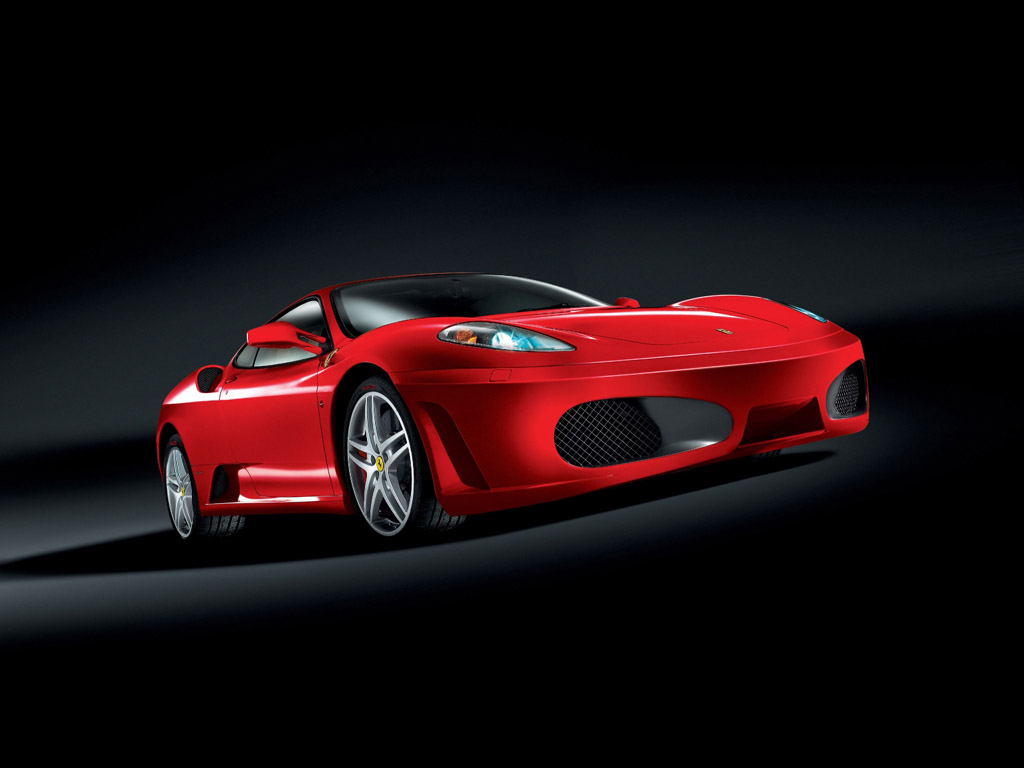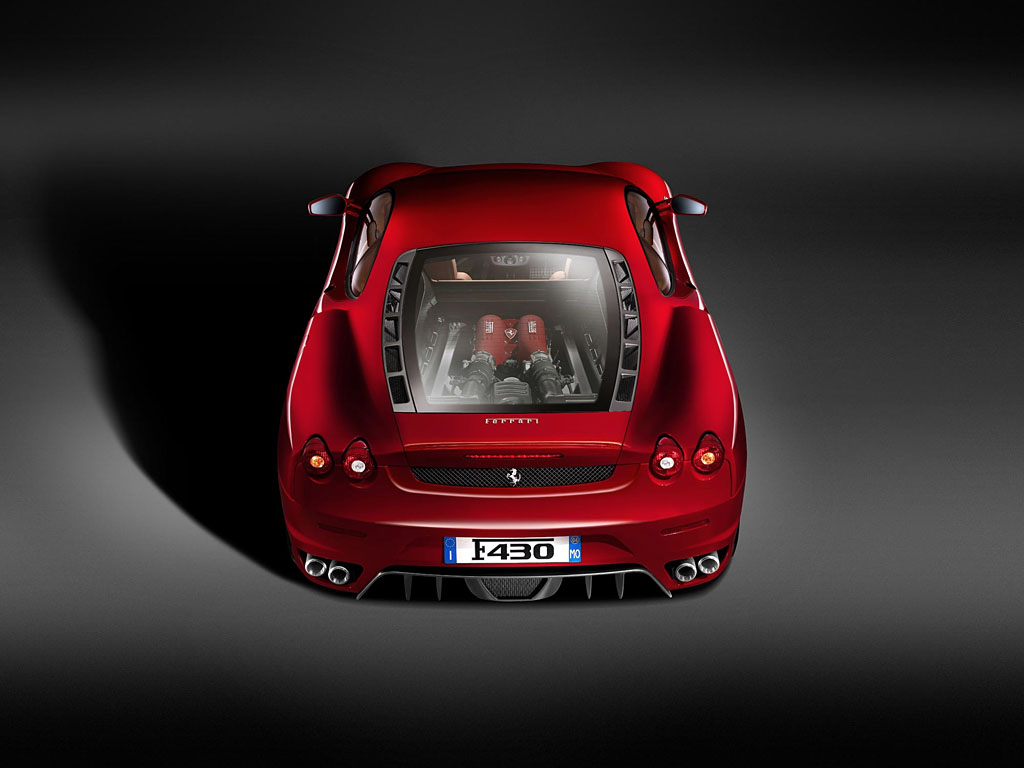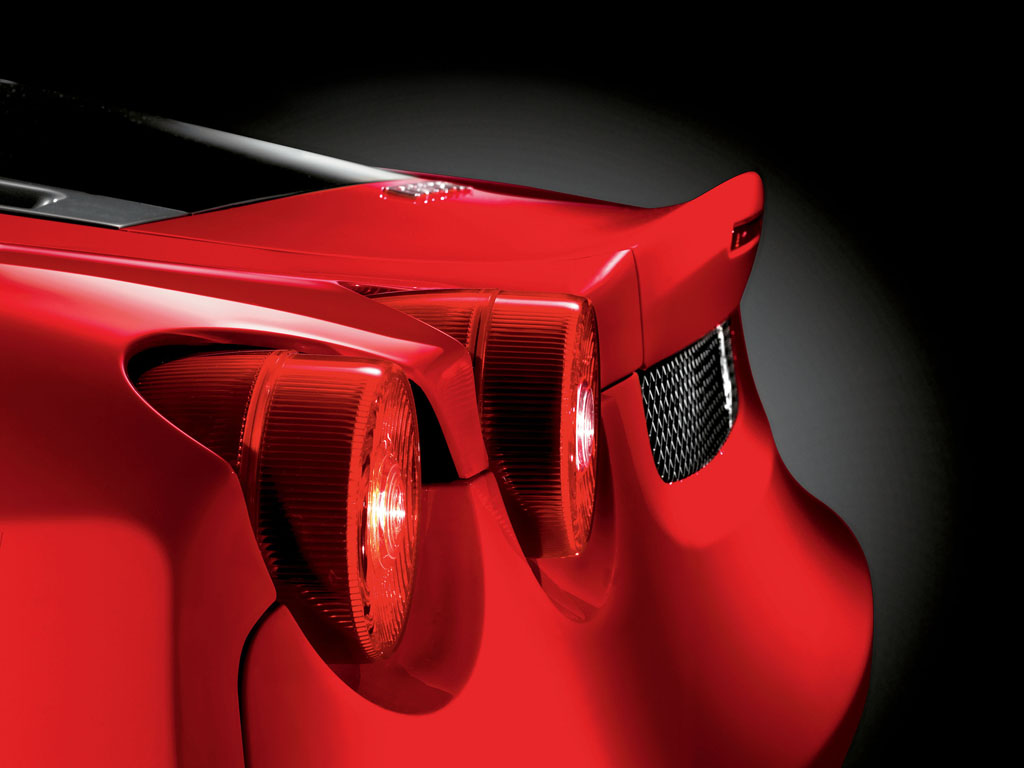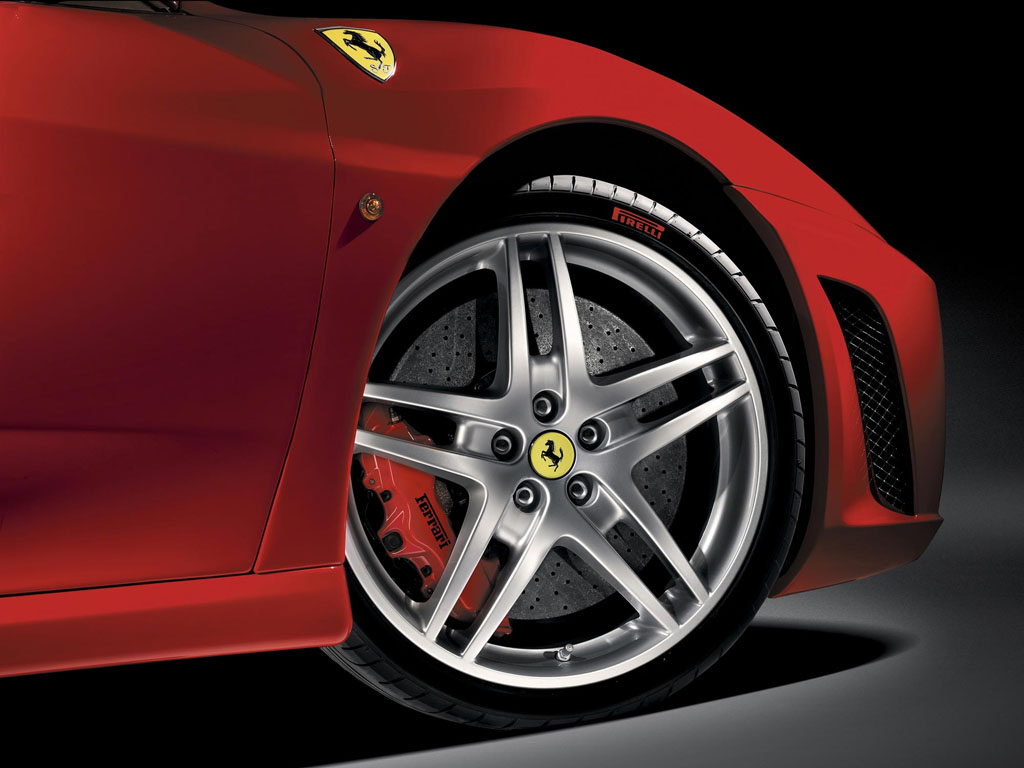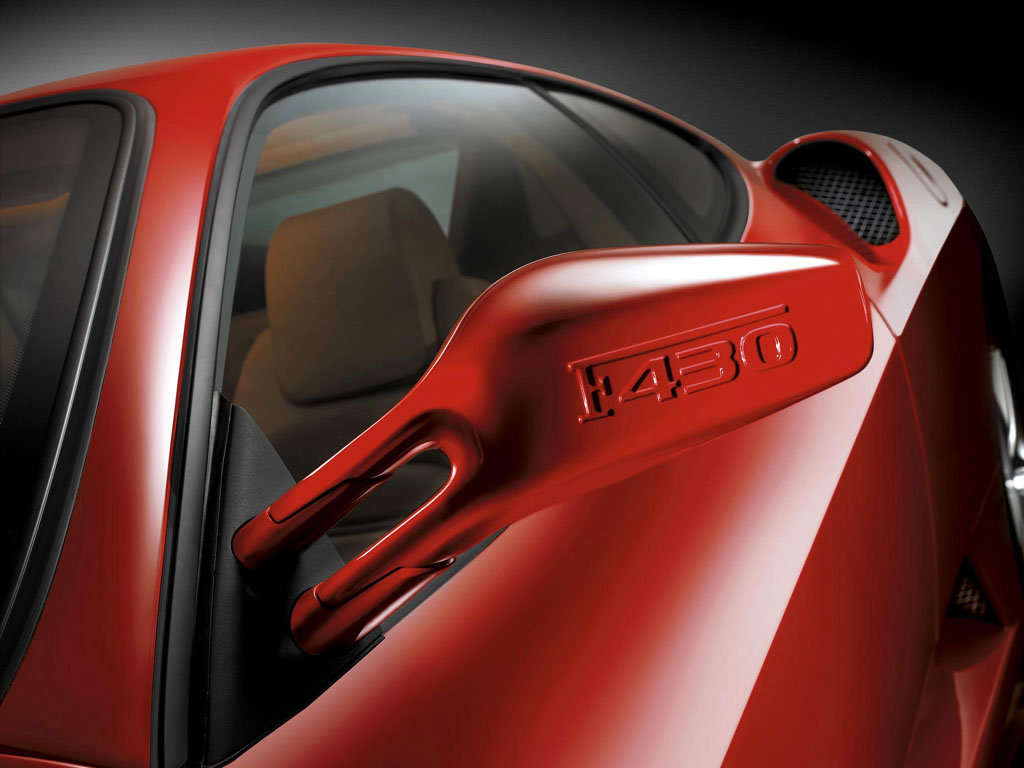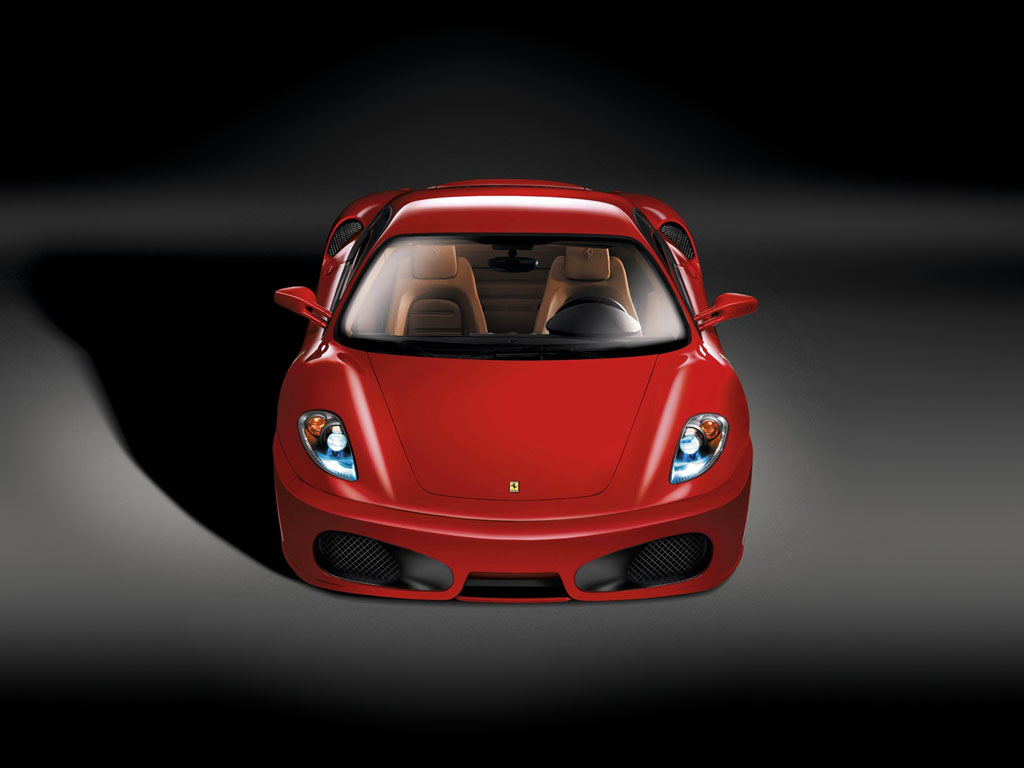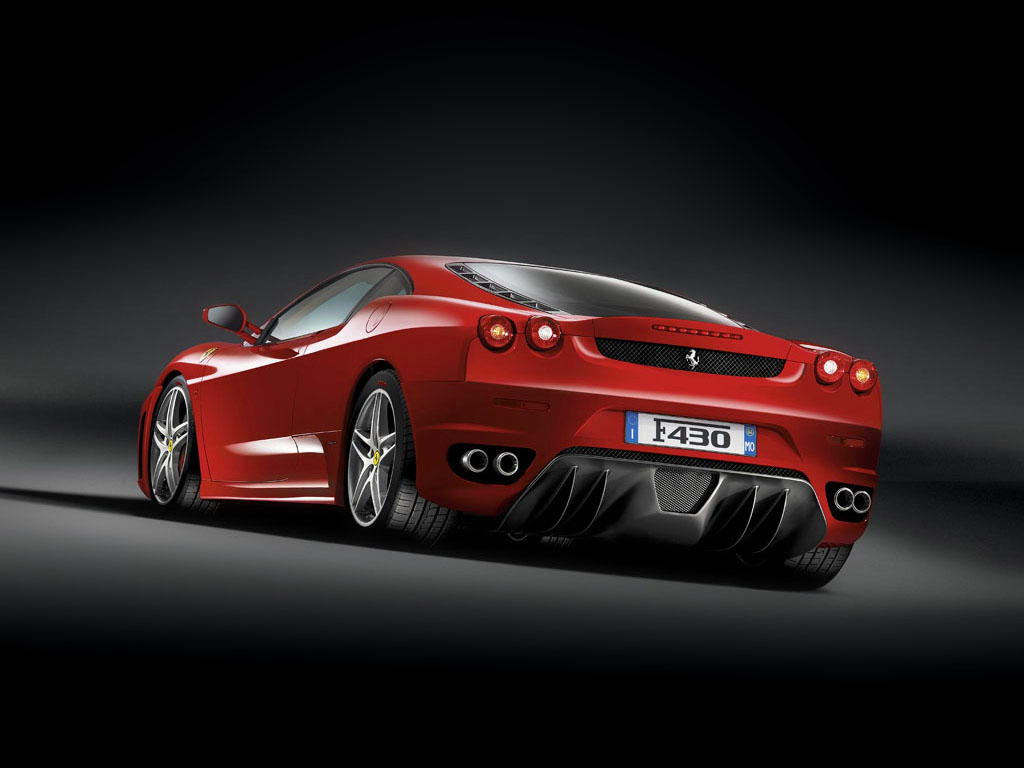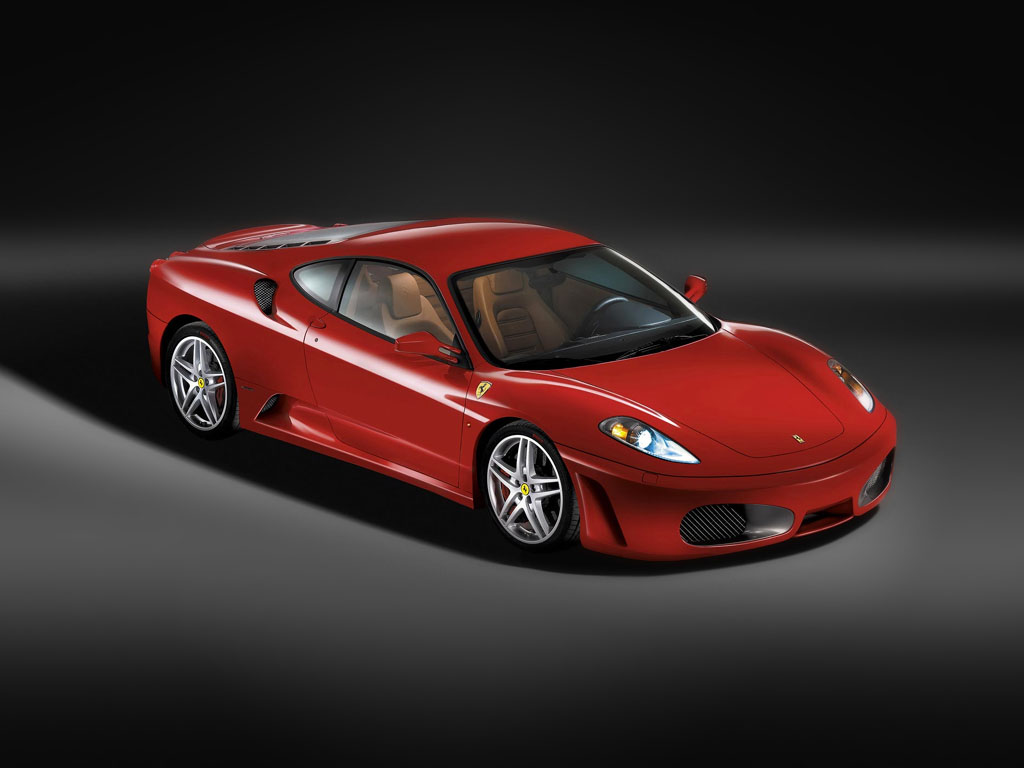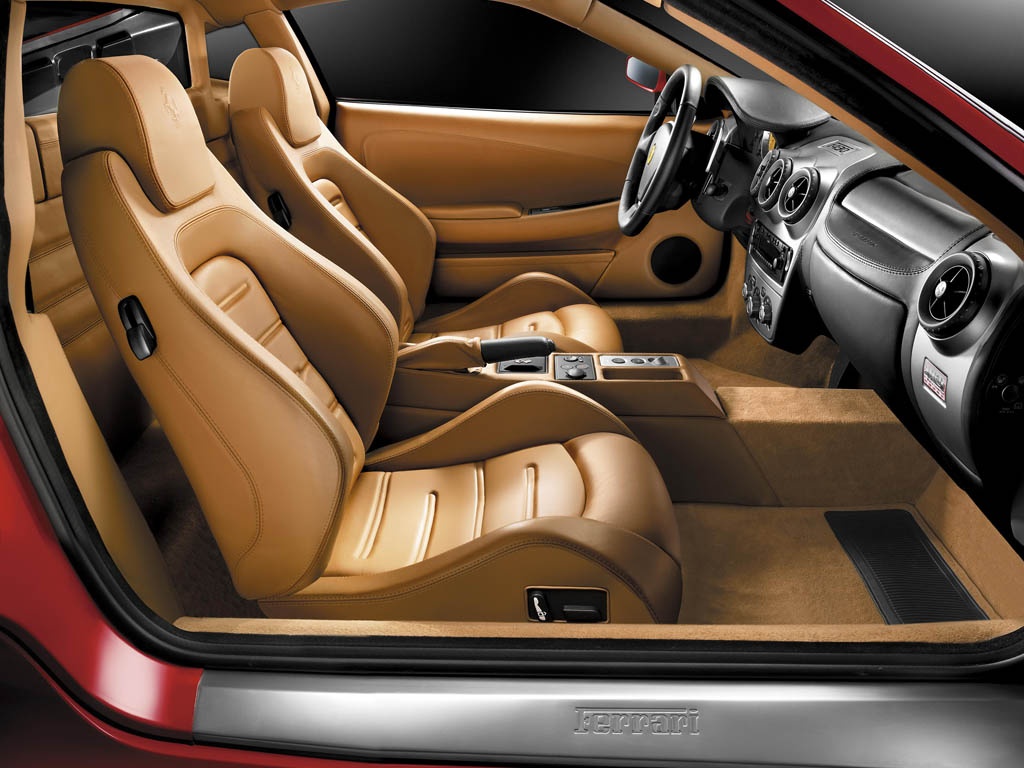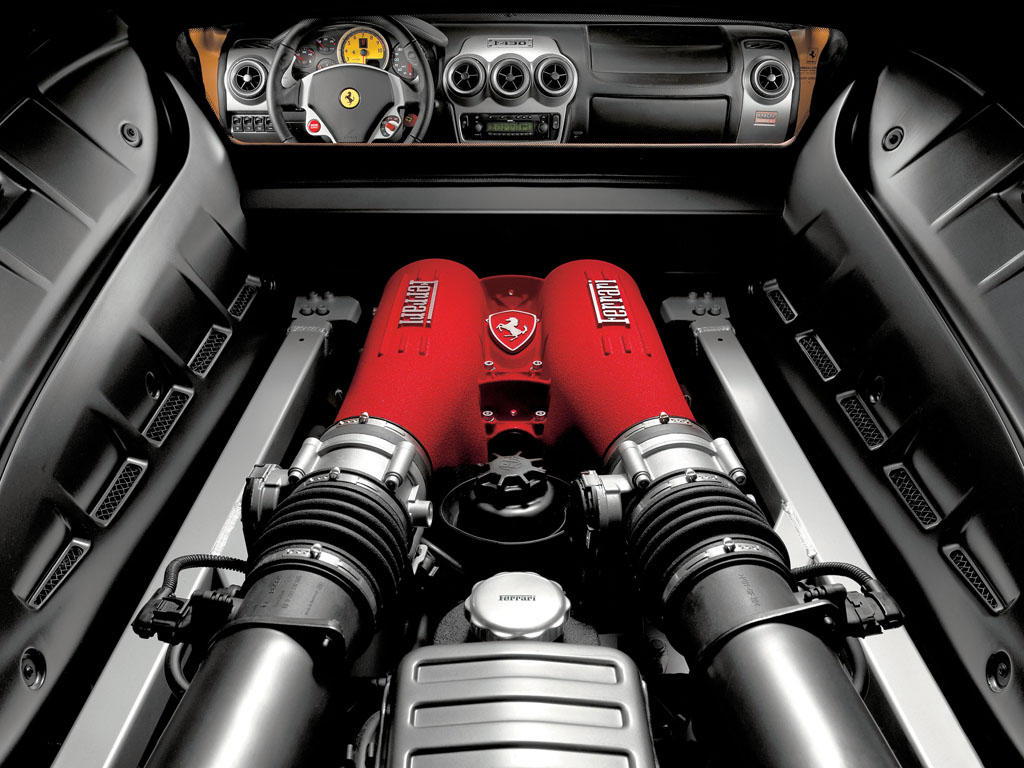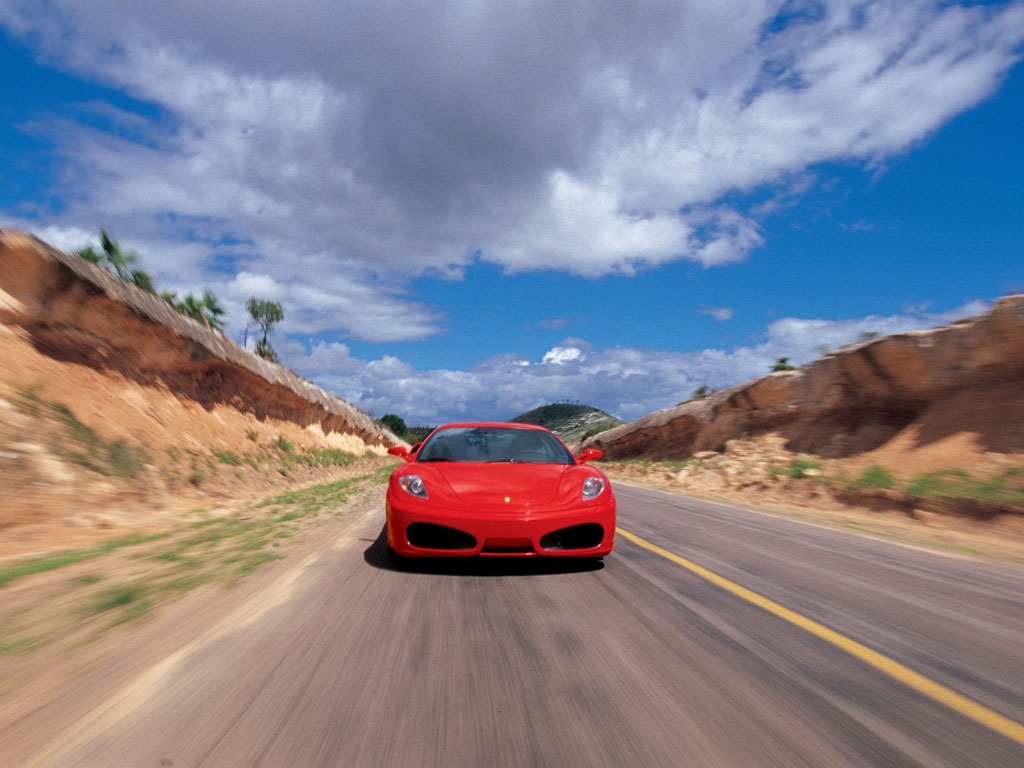Ferrari F430
Officially presented during the Paris Motor show in September 2004, the F430 signaled the arrival of a brand new generation of Ferrari 8-cylinder models.
This new car takes Ferrari’s achievements with aluminium technology, begun with the 360 Modena, to the next level, and offers a series of significant innovations improvements inspired from Ferrari’s Formula One program. Two of these innovations are world firsts for production cars: the electronic differential (E-Diff) and the steering wheel-mounted switch (better known to the Formula 1 Scuderia’s drivers as manettino), which manages the integrated systems governing vehicle dynamics.
Engine
The F430 is powered by a new V8 that does not share any components with the 360 Modena’s engine. The improvement in terms of performance, weight and reduction of overall dimensions is the result of Ferrari’s Gestione Sportiva F1 racing division. Despite a 20% increase in engine displacement (from 3586 cc to 4308 cc), engine weight has grown minimally by just 4 kg, while performance is considerably improved across the board; torque increases by 25% and power by 23%.
In line with the latest developments, F430 has new 4-valve cylinder heads, inlet tracts and valve diameters. Twin overhead camshafts actuate with continuously variable timing on both inlet and exhaust cams, and the valve gear is driven by hydraulic tappets. Timing is guaranteed by a high pressure hydraulic system (20 bar), obtained by using a supplementary pump, an external accumulator and a circuit that works in parallel with the oil circuit for the hydraulic tappets. This ensures that a full timing cycle is completed in 0.1 seconds. Ferrari has dropped the mixed gear/toothed belt distribution system for a chain-driven system, thus reducing the overall length of the engine. Crankshaft, con rods and pistons are also all-new.
The dry sump lubrication system comprises a series of external pumps (thus reducing the overall height of the sump) and a circuit that has been optimised by eliminating the oil radiator and introducing a water/oil heat exchanger mounted inside the engine vee. Three scavenge pumps guarantee that excess oil is drawn out of the bottom of the cylinder block under all driving conditions, creating a strong vacuum around the crankshaft and thus reducing power loss through attrition, the act of rubbing together.
The intake manifold features two central plenums which have trumpets individually cast at the top of the tracts for each cylinder. A rotating drum, actuated pneumatically by the engine control unit, compensates for variations in the effective volume inside the two plenums to optimise the intake resonance characteristics and maximise the torque throughout the rev range.
E-Diff Electronic Differential
One of the technical features that sets the F430 apart is the E-Diff or electronic differential. This solution has been used for years in F1 single-seaters and has been continuously developed and refined, effectively transferring massive torque levels under high cornering g-forces. On the track, the E-Diff guarantees maximum grip out of bends, eliminating wheel spin. This system is available both on the F1-paddle shift version as well as on the manual gearbox model and consists of three main subsystems:
– a high-pressure hydraulic system, shared with the F1 gearbox (if present);
– a control system consisting of valve, sensors and electronic control unit;
– a mechanical unit housed in the left side of the gearbox.
Torque is continuously distributed between the wheels via two sets of friction discs (one for each driveshaft) controlled by a hydraulic actuator. The amount of torque actually transmitted to the driven wheels depends on driving conditions (accelerator pedal angle, steering angle, yaw acceleration, individual wheel rotation speed) and brings considerable advantages in terms of performance, direction stability, active safety and handling feedback. The electronic differential actively helps reduce Fiorano lap times by three seconds compared to the 360 Modena.
A new cast-aluminium transmission casing houses the gearbox in unit with the electronic differential and bevel type final drive, as well as the engine oil tank. The 6-speed gearbox incorporates multicone synchronizers, while both the 6th gear and the final drive have been lengthened to make the most of the greater power and torque of the new engine. The F430 is available with either the classic Ferrari open-gate manual gearbox or with the F1 paddle shift that Ferrari has continuously developed and refined over recent years for its road-going berlinettas. Changing gears takes just 150 milliseconds.
Manettino
Just like in Formula 1, the F430 driver can change the set-up of his car using the selector set on the steering wheel. The manettino is a rotary switch that has been adopted directly from racing. This switch quickly and simply controls the electronics governing suspension settings, the CST stability and traction control, E-Diff and the change speed of the F1 transmission, as well as the integration between each of these individual functions.
The manettino enables car settings to be changed to suit the personal preferences of the driver, road surface conditions and available grip. The settings available to the driver have been concentrated in five different strategies. These, in ascending order according the level of performance (grip), are: Ice, Low Grip, Sport, Race & CST which activates or deactivates the stability and traction control.
Suspension
The F430 also introduces new-generation adaptive suspension for the first time on a V8-engined Ferrari to provide a balance between handling and comfort. Sensors are mounted to read suspension travel, measure body movement, roll and yaw, with a last sensor on the steering column to measure steering angle. The control logic adjusts the shock absorbers’ damping characteristics within a certain range based on the settings selected by the driver using the manettino on the steering wheel.
Working in close collaboration with Brembo, Ferrari’s engineers have developed a new cast-iron alloy for the discs which includes molybdenum for better energy/heat dissipation. This new alloy provides significantly improved braking performance without increasing the size. An outstanding alternative is the option to ordrer carbon-ceramic discs.
Aerodynamics
The F430’s aerodynamics has brought about a 50 percent increase in downforce compared to the 360 Modena, thus increasing high-speed stability and the car’s active safety. At 124 mph (200 km/h), that figure equates to 45 kg more downforce than the 360 Modena and this becomes 85 kg at 186 mph (300 km/h), amounting to a total of 280 kg.
The significant progress made in the car’s aerodynamics is also reflected in the improvement of the ratio between the coefficient of downforce (Cl) and the drag coefficient (Cd) with a 40% improvement over the 360 Modena. This excellent result was in part achieved by including a new spoiler at the bottom of the front bumper where it cleaves clean air, i.e. that still undisturbed by the turbulence generated around the body of the vehicle. Lengthy development of the shape and the angle of attack of the spoiler resulted in an impressive increase in downforce over the front axle, up to 130 kg, which contributes in no uncertain manner to longitudinal vehicle stability and steering precision.
The rear wheels feature fences (deflectors) like those used on Ferrari’s single-seaters, and increases the speed of air flow under the tail of the car creating an area of depression and ground effect that pulls the car down. In this conformation, the underbody actively helps increase downforce to a maximum of 150 kg over the rear axle. Aerodynamic development also had a part in extracting the maximum performance from the new 4.3-litre V8. The two intakes for the engine are positioned over the driven wheels in an area of high flow pressure, thus guaranteeing a greater volume of air to the intake manifold.
Pininfarina’s Exterior Design
Pininfarina’s body design is born from the F430’s exceptional technical features. In fact, all body design features emphasise the car’s aggressive style and respond to precise functional requirements as regards engine cooling flows and fuel feed, aerodynamic properties, the sophisticated shape of the floorpan to ensure adequate negative lift.
The front-end is marked by two elliptical air intakes that feed the large radiators required to dissipate heat from the high-powered engine. Inspiration for the shape was taken from the 1961 Ferrari racing cars, F1 world champions that year with Phil Hill. The lower section of the air intakes are joined by a small spoiler that conveys the flow towards the flat underside.
The lighting units extend longitudinally and are extremely compact, thanks to the use of bixenon technology that means all functions can be combined in one highly efficient headlight. With the lights on, the singular shape of the parking lights, which emphasise the external profile of the lighting cluster, makes the car immediately recognisable even when driving at night.
In front of the front wheels, generously-sized air outlets direct the airflow from the radiator along the sides of the body. On the lower sides of the body there are two substantial air intakes conducting the flow towards the brakes and oil radiator.
The rear section re-proposes features that gave the Enzo supercar such a great personality: the headlights extend 3-dimensionally upwards, while the under-body extractor with its very precise, complex aerodynamic design is the most important feature of the lower section. An air outlet has been opened at the rear to improve cooling in the engine compartment.
Every effort has also been made to design single components that emphasise the car’s uniqueness and performance: The dual 5-spoke 19 wheels are a combination of the classic Ferrari design and exceptional performance in terms of rigidity and light weight. The mirrors, with the model indication on the driver’s side, are supported by a double arm as they were on the Testarossa in the ’80s. Also the exhaust manifolds, which together with rear light units are one of Ferrari’s characteristic features, have a hi-tech, aggressive design.
Pininfarina’s Interior Design
Efforts have been made to break momentarily with the trend towards a wealth of features, and more weight, when designing the interior. And so the F430 adopts the philosophy used on the Enzo, which aimed at functionality with no frills and the use of hi-tech materials.
The facia, the only dark-coloured feature in the interior, is a suspended shape limited in size to meet the minimum requirements from a technical standpoint. Functional features, incluging the air outlets, heating controls and radio are lodged in carbon-fibre fixtures. The instruments include a large, centrally positioned rev counter on a yellow background, highlighted by an outer metal ring nut.
The most important controls have been located on the steering wheel; for instance, the ‘little lever’ that commands systems governing the car’s dynamics in an integrated manner and the starter button. The door panels have a simple, functional design in line with the philosophy behind this car, as has the central tunnel, which again has been reduced to the minimum.
Carrozzeria Scaglietti Personalisation Program
Carrozzeria Scaglietti offers a personalisation programme for the F430. Owners can also choose a colour for their car’s bodywork that is not included in the standard range or even supply their own sample. Scuderia Ferrari shields can be fitted to the wheelarches too and red, yellow or aluminium brake callipers can be specified at the time of order. Challenge-style wheels are also available.
The F430’s interior can be personalised in any number of ways: owners can chose between various leather trim colour combinations or opt for Daytona-style upholstery with perforated inserts. There’s even a special leather trim for the rear of the cabin. So detailed is the programme that even the colour of the thread and the spacing of the stitching can be specified. The Travel options include an upgraded stereo system with sub-woofer, a satellite navigation system, and a Bluetooth connection for your mobile to the speakerphone system built into the radio. An exclusive luggage set, specially tailored to fit the F430, is also available.
Specs & Performance
| submitted by | Richard Owen |
| type | Series Production Car |
| production years | 2004 – 2009 |
| released at | 2004 Paris Motor Show |
| built at | Maranello, Italy |
| body stylist | Frank Stephenson |
| coachbuilder | Pininfarina |
| price $ | $ 171,000 |
| price €/td> | €175,000 |
| price £/td> | £118,500 |
| predecessor | 2000 Ferrari 360 Modena |
| engine | Aluminum Alloy, 90 Degree V8 w/Dry Sump Lubrication |
| position | Mid Longitudinal |
| aspiration | Natural |
| valvetrain | DOHC, 4 Valves per Cyl w/Variable Timing, Variable Intake Tract |
| fuel feed | Electronic Sequential Injection |
| displacement | 4308 cc / 262.9 in³ |
| bore | 92 mm / 3.62 in |
| stroke | 81 mm / 3.19 in |
| compression | 11.3:1 |
| power | 360.2 kw / 483 bhp @ 8500 rpm |
| specific output | 112.12 bhp per litre |
| bhp/weight | 333.1 bhp per tonne |
| torque | 638 nm / 470.6 ft lbs @ 6250 rpm |
| redline | 8500 |
| body / frame | Aluminum Monocoque |
| driven wheels | RWD w/E-Diff, CST |
| front brakes | Carbon-Ceramic Discs |
| rear brakes | Carbon-Ceramic Discs |
| front wheels | F 48.3 x 19.0 cm / 19 x 7.5 in |
| rear wheels | R 48.3 x 25.4 cm / 19 x 10 in |
| steering | Rack & Pinion |
| f suspension | A-Arms w/Coil Springs, Electric Adj Tube Shocks, Anti-Roll Bar |
| r suspension | A-Arms w/Coil Springs, Electric Adj Tube Shocks, Anti-Roll Bar |
| curb weight | 1450 kg / 3197 lbs |
| wheelbase | 2600 mm / 102.4 in |
| front track | 1669 mm / 65.7 in |
| rear track | 1616 mm / 63.6 in |
| length | 4512 mm / 177.6 in |
| width | 1923 mm / 75.7 in |
| height | 1214 mm / 47.8 in |
| transmission | Manual or F1 Paddle Shift |
| gear ratios | 3.29:1, 2.16:1, 1.61:1, 1.27:1, 1.03:1, 0.82:1 |
| top speed | ~318.7 kph / 198 mph |
| 0 – 60 mph | ~3.9 seconds |
| 0 – 100 mph | ~8.3 seconds |
| 0 – 1/4 mile | ~11.9 seconds |



